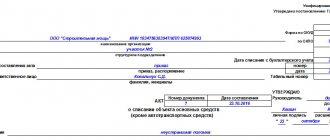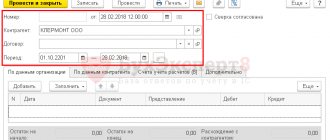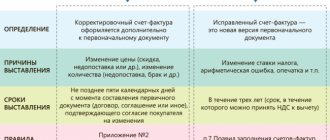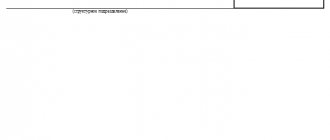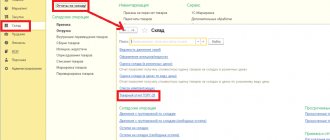An act in the TORG-3 form is used by organizations conducting foreign economic activity, because they may also be faced with a situation where the supplier sent low-quality goods. The document must be drawn up only when it comes to the receipt of imported products; it is not suitable for domestically produced goods.
A correctly executed TORG-3 act, a sample of which can be found below, is necessary to appeal the fact of delivery of products whose characteristics do not correspond to those declared by the seller. In the document, the recipient of the goods must indicate any discrepancies found in quality and quantity. Based on the executed TORG-3 act, the organization’s management files a claim with the supplier demanding compensation for the damage caused. Also, the purchasing organization has the right to demand a replacement of the goods received or a refund of the money transferred.
Forms TORG-2 and TORG-3 perform similar functions. The only difference between them is that TORG-2 is compiled for domestically produced products, and TORG-3 is compiled for imported products.
General rules for drawing up the TORG-3 form
The act is drawn up in the presence of a special commission. The commission must include representatives of the supplier and the company receiving the goods, as well as a representative of an independent organization or expert.
Form TORG-3 is drawn up for each consignment received under one transport document. The act is drawn up in 5 copies, one for each interested party:
- for the accounting department of the recipient of the products;
- representative of the supplier company;
- a representative of a disinterested organization that took part in drawing up the act;
- for the transport company that delivered the goods;
- a copy for filing a claim.
The report is drawn up only for those product items for which discrepancies were identified. The remaining items do not need to be listed, but at the end of the document it should be noted that there are no inconsistencies for other items. The document must be issued on the day the goods arrive at the warehouse. A sample of filling out the TORG-3 form in 2021 will be given below.
Who should sign the act in form TORG-3:
- the head of the recipient of the goods;
- chairman and members of a specially created commission;
- expert or representative of a disinterested organization.
The act will have legal force only if independent participants take part in the product acceptance process. These may be representatives of the Chamber of Commerce and Industry, an expert or other organization. The supplier's representative may not be present, but the management of the supplier company must give their consent to the drawing up of the act without his presence.
Formation of the commission
Only a special commission can accept goods received during the execution of a foreign economic contract. It is not always created, but only in cases where there are discrepancies between the shipped and arrived goods.
The commission includes:
- buyer representatives;
- authorized person of the seller;
- expert of the examination bureau of the Chamber of Commerce and Industry or other disinterested organization.
The seller must be notified of the creation of a commission. After receiving the notification, he sends his representative. If this is not possible or the seller ignores the sent request, a representative of a third organization that is not interested in the result is invited to participate in the work of the commission. According to established custom, a representative of the Chamber of Commerce and Industry of the corresponding region is invited, since he meets the requirement of competence in matters of acceptance of goods. The commission is created immediately after the expiration of the period provided for the response. Since transport downtime is paid additionally.
The seller who has not sent his representative must give his consent to acceptance in the absence of an authorized representative. The tasks assigned to the commission include the responsibility for conducting expert research.
Document structure
- Front page. Information about the delivery participants and the method of delivery of the goods is displayed here.
- A table indicating the discrepancy between the quality and quantity of goods and materials actually supplied and the data specified in the accompanying documentation.
- Conclusion of the commission.
A separate act must be drawn up for each batch of goods. The finished sample of TORG-3 can be used as a basis when drawing up a similar document for your organization.
Sample of filling out a statement of discrepancy
Filling out the first page of the TORG-2 form
At the beginning of the document, information about the company to which the goods arrived is written:
- its full name,
- address,
- telephone,
- OKPO code,
- Kind of activity,
- structural unit that accepted the cargo
- a link to the document that served as the basis for drawing up the act (usually an order or instruction from the director).
All entered data must be identical to those specified in the constituent documents.
The act must be assigned a number and the date of its writing must be entered on the form. The lines on the right reserved for approval are filled in by the head of the company.
Further, in the “Place of acceptance” paragraph, the actual address of receipt of the cargo is indicated, the date of delivery and a link to the accompanying documents (indicating their name, number, date of creation) are noted. The method for calling the representative of the consignor of the goods is also entered here and the lines dedicated to the shipper, manufacturer, supplier are filled in - everywhere you need to indicate the appropriate name of the company, address, contact phone number.
If the product was insured, this should also be noted by entering information about the insured.
The following part of the act includes:
- data on the documents on the basis of which the delivery was made (link to the contract, invoice number, and if necessary, you should also enter the number of the railway invoice, veterinary certificate, commercial act);
- delivery method (railway, water or air transport, car, etc.);
- departure date;
- some details about the loading location (warehouse, pier, station, terminal, etc.).
Below is a table in which you need to enter the exact time of departure and arrival, opening, and delivery of the cargo (down to minutes). If there were any pauses during the unloading period, this should also be noted.
Filling out the second page of the TORG-2 form
The second page of the TORG-2 form begins with entering information about the condition of the vehicle, as well as the presence of labels, seals and other markings on the products.
The following information is entered into the table:
- imprints on the cargo,
- number of occupied seats,
- type of packaging (bag, box, container, pallet, etc.),
- product name,
- everything related to weight (unit of measurement, net-gross).
If there is any special additional information, it should be entered in the last column. Under the table it is necessary to indicate whether facts of violation of the integrity of seals or labels were recorded.
The second table on this page of the act concerns the discrepancy information : first, the indicators from the accompanying documents filled out by the sender are entered here, then those that were received when checking the received cargo. As a result, a discrepancy is entered (with a + or - sign).
Another table contains detailed information about the product (if there are several items, then a separate line is allocated for each of them). This includes:
- his name,
- seat number in the vehicle,
- unit of measurement (in words and in code),
- article (if available),
- variety,
- quantity,
- unit price),
- total amount.
Filling out the third page of the TORG-2 form
The following information is indicated on the third page of the act.
- Information about storage and transportation conditions. Here you can enter any parameters that can affect the quality of the product: temperature, humidity, lighting, air exchange, etc.
- The condition of the packaging and labeling at the time of external inspection, as well as the correspondence of the stamped cliches to the sender’s labeling.
- The date the container was opened, and it is also stated (or not stated) that the prints and seals correspond to the condition indicated in the shipping papers.
- Information about the inspection (whether it was random or complete) and how it was carried out; if the inspection was selective in nature, then you need to write the basis for its conduct.
In the table on page three you need to write data about those parameters of the cargo that were recorded at the time of acceptance: grade, article, quantity, price, amount.
If a defective or defective cargo has been identified, this should also be included.
Then deviations are recorded (shortages or surpluses - quantity, amount of the difference) and the product passport number, if any.
Common mistakes when filling out the TORG-3 form
- Using the TORG-2 form instead of TORG-3. Some entrepreneurs confuse these documents and file discrepancies using a form intended for internal circulation. Also, instead of TORG-3, sometimes a 3-TORG PM act is drawn up, intended for small enterprises.
- Execution of the act by a commission with an incomplete composition. In the future, this may become a reason for the supplier to refuse to compensate for the damage.
- Incorrect or incomplete description of identified product defects.
Sample
If a defect is detected, you should carefully fill out the table on page 3. An approximate sample of filling out TORG-2 in 2021 if there is a defect looks like this:
Legal documents
- Resolution of the State Statistics Committee of Russia No. 132 of December 25, 1998
- inf. Ministry of Finance of Russia No. PZ-10/2012 dated December 4, 2012
Procedure for document execution
Filling out TORG-3:
- On the title page, in the corresponding lines, indicate information about the organization that received the goods: name, structural unit, OKPO and OKDP code.
- Next, write down the number of the act and the date of its preparation.
- Below you should display information about the place of receipt of goods and materials, the consignor, accompanying documents, etc.
- After this, you must indicate the details of accompanying and other documents: agreement for the supply of goods, waybill, quality certificate, etc.
- Below indicate the delivery method, the date of dispatch of the goods, the name of the warehouse from which the goods and materials were sent, and other information.
- At the top of the document, under the heading “I approve”, the head of the organization signs.
The next part of the TORG-3 form is in the form of a table in which you must indicate:
- name of the product for which discrepancies were found and its code;
- unit of measurement;
- data from accompanying documentation;
- factual data;
- number of defective, missing goods;
- identified shortages and surpluses;
- passport ID.
Below the table, space is provided for the commission’s conclusion on the reasons for the detected inconsistencies. The prepared act is signed by all members of the commission.
TORG-3 can be further.
How to fill out the TORG-2 form
The form consists of four pages. You can fill out the form using a ballpoint pen or on a computer. If the goods and materials were insured, information about the insurer is indicated in the document.
Form TORG-2 is filled out as follows:
- General information about the recipient is indicated in the header of the document;
- Next, you must indicate the date of drawing up the act, information about the shipper, contract and invoice numbers;
- also on the 1st page indicate the method of cargo delivery, the date and time of arrival at the warehouse and acceptance of goods and materials;
- on the 2nd page, the condition of the seals and the transport that delivered the goods, the characteristics of the goods being transported are noted;
- on the 3rd page information is written about the storage conditions of goods until they are opened by the supplier, the condition of the packaging, etc.; in a special table it is necessary to indicate information about the discrepancy in the number of places and the weight of goods and materials received and the amount of damage caused;
- on page 4 you should indicate where and in what way the quantity (weight) of goods was determined; here the detected defects are described in detail and the conclusion of the commission is given;
- at the very bottom of the 4th page, members of the commission affix their signatures. A line is also provided there to confirm receipt of the act by the accounting department and the manager’s decision regarding the identified discrepancies is recorded (he also approves the act on the first page).


